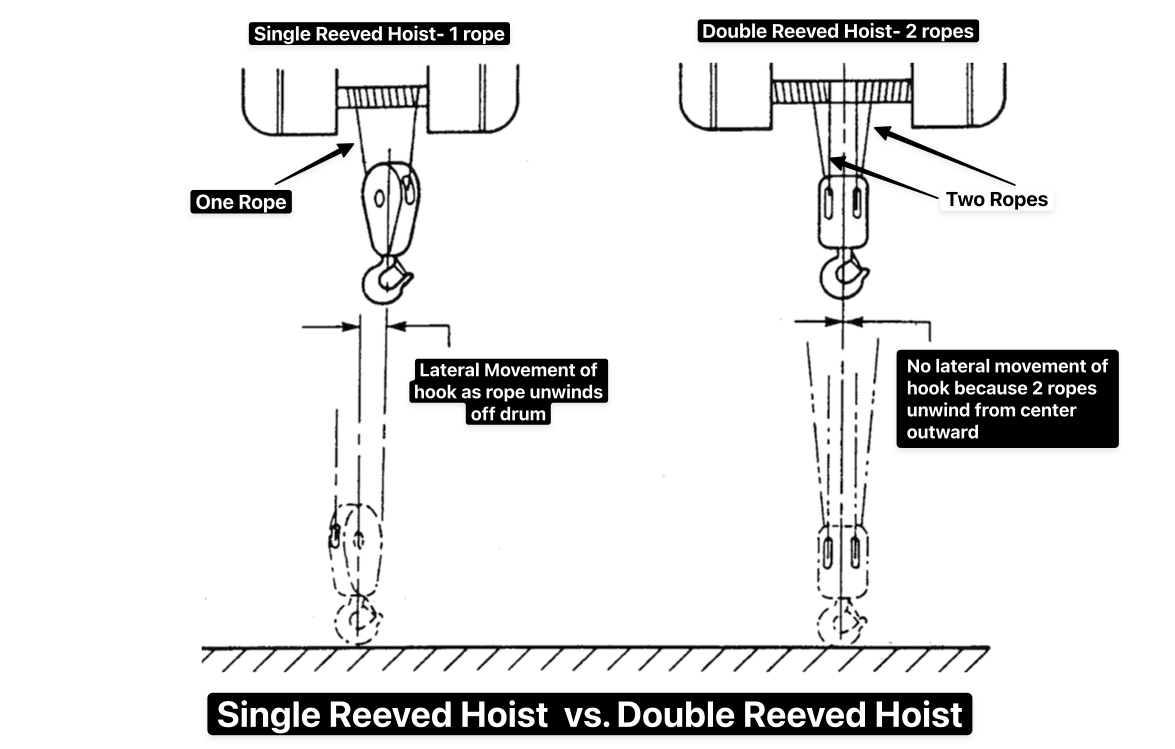What is TVL, and when is it needed?
Sometimes it's called TVL, and other times it's True Vertical Lift. To people familiar with the topic, it's normally referred to as single reeved vs. double reeved hoist. Regardless of the name, the buyer needs to understand the concept prior to purchasing an overhead crane.
True Vertical Lift refers to a rope-type electric hoist's ability to raise or lower a load in a perfectly straight, vertical line without any lateral (sideways) or horizontal movement of the hook [1][5][9]. Choosing the appropriate hoist reeving is critical in applications requiring precise load placement, such as aerospace assembly, injection molding, or positioning components onto exact locations [6][9].
If you purchased a single-reeved hoist (the lifting part of a Crane) and, after the bridge crane has been installed, your production people tell you that they needed the hook to lift straight up and down with no lateral travel, there is NO WAY TO FIX THE PROBLEM!!! It is imperative that you know what TVL/True Vertical Lift is, and further, know what configuration of hoist your production people need to perform their job. This is not something your overhead crane supplier can decide for you, and this is the buyer's sole responsibility.
How True Vertical Lift Is Achieved
Wire Rope Hoists: True vertical lift is typically achieved using a double-reeved wire rope hoist. In this configuration, two wire ropes are anchored at each end of the drum and wind or unwind simultaneously from the center toward the ends (or vice versa). Double reeving ensures the hook remains centered under the drum throughout its travel, eliminating hook drift and any horizontal movement[1][2][5][7][9][11].
Just remember;
- Single Reeved
Lateral hook movement is the hook’s movement from the floor to its uppermost level, as shown above, in the left drawing.
- Double Reeved
Zero lateral hook movement at all elevations, as shown above in the right drawing.
Chain hoist Pocket Wheel Drive
Chain Hoists: By design, chain hoists always provide true vertical lift, as the chain moves directly up and down over a chain pocket wheel and therefore without causing lateral movement of the hook[1][6][12].
To put it another way, only when the hoist has a drum can the hook move laterally as the rope unwinds from the drum, whereas with a chain hoist, there is no drum and the hook always remains on the center line of the chain pocket wheel.
Double Reeved Wire Rope Drum
Importance and Applications
True Vertical Lift is essential for:
Precision assembly operations where even slight side-to-side movement can disrupt the process[3][9].
Lifting operations in industries such as aerospace, pharmaceuticals, and specialty manufacturing, where exact positioning is critical[6][9].
True Vertical (Double Reeved) vs. Single Reeved
Warning- True-Lift vs True Vertical Lift
In recent years, Kone Cranes (and its US sister company, R&M Hoist) introduced a large diameter drum hoist and a term called "true-lift." The large diameter drum reduces horizontal hook travel for a given amount of vertical travel compared to a standard drum diameter. In the case of the Kone/R&M hoists, the large drum is claimed to produce only 1/8 inch of horizontal movement for every foot of lift.
It is essential to understand that this is still a single-reeved hoist, and the hook still has horizontal drift. Therefore, it is not "True-Vertical Lift." Consequently, the buyer must determine if the 1/8 inch of drift meets their requirements. If you can live with the hook drift of the large drum hoist configuration, some ancillary benefits of the large drum design are worth considering.
Summary
Hoist reeving is one of the most overlooked considerations when first-time buyers list their desired Overhead Crane performance characteristics. “True Vertical Lift” means the load is lifted and lowered in a perfectly vertical path, with no lateral hook movement. This is achieved through double-reeved wire rope configurations and is vital for applications requiring precise load positioning and placement [1][2][5][9][11][13].
When talking to a prospective Bridge Crane supplier, hoist reeving is a good topic to judge the vendor's knowledge. After telling the vendor your desired capacity, span, height, and lift of your crane, the desired hoist reeving should be one of his first questions.
“
If the vendor fails to bring up hoist reeving and its importance to your operational needs, it’s time to find another crane vendor with the experience to ask you the right questions.
”
Sources
[1] Understanding True Vertical Lift | Crane1 https://crane1.com/understanding-true-vertical-lift/
[2] True Vertical Lift Vs. Single-Reeved Hoist | R&M Materials Handling https://rmhoist.com/about-us/blog/true-vertical-lift-single-reeved-hoist
[3] Understanding True Vertical Lift - Cranes-UK https://cranes-uk.com/blog/understanding-true-vertical-lift.html
[4] What is True Vertical Lift - Reva Cranes https://www.revacranes.com/true-vertical-lift/
[5] Learn about TRUE VERTICAL LIFT - American Crane https://www.americancrane.com/learn-about-true-vertical-lift/
[6] What is "True Vertical Lifting" of Electric Hoist? Precise Hoisting https://www.eotcranekit.com/blog_parts/true-vertical-lifting-of-electric-hoist.html
[7] Achieving True Vertical Lift for Precise Lifting - Hoist UK https://www.hoistuk.com/achieving-true-vertical-lift-for-precise-lifting-with-a-wire-rope-hoist/
[8] Overhead Crane Hoist Types and Design: Manual, Electric, and Air https://www.mazzellacompanies.com/learning-center/overhead-crane-hoist-types-design-wire-rope-chain-manual-electric-air/
[9] Precision Lifting & Wire Rope Hoists | Double Reeved Hoists https://www.sbomh.com/blogs/hoist-guys-blog/true-vertical-lift-for-precise-lifting
[10] Crane Reeving Definition, Types & Diagram - CraneTech https://www.cranetechusa.com/crane-reeving/
[11] Overhead Crane Definitions https://www.tsoverheadcrane.com/overhead-crane-definitions
[12] Operations, Industries and Uses of Overhead Cranes - IQS Directory https://www.iqsdirectory.com/articles/crane/overhead-crane.html
[13] Glossary of Overhead Cranes Terminology - EMH, Inc. https://www.emhcranes.com/glossary-of-overhead-cranes-terminology/ [14] What are the Different Types of Hoists for Overhead Cranes | Blog https://amquipinc.com/different-types-of-hoists/




